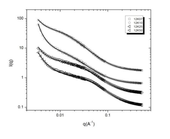Highlight
Poly(ethylene glycol) Hydrogels with Unique Network Architectures for Tissue Engineering and Biomaterial Applications
Achievement/Results
Biomaterials are currently being used for many different applications including joint replacements, artificial ligaments, and dental implants, and new applications are constantly being developed. The field of tissue engineering focuses on the repair or replacement of diseased tissues. The materials used in biomedical applications must be formulated to be biocompatible, while at the same time providing the correct structural environment for the desired application.
Hydrogels are a class of materials that are considered excellent candidates for biomedical applications due to their attractive properties, such as high water content, porous gel network and easily manipulatable gelation conditions. However, network inhomogeneities make it difficult to predict their behavior in vivo and compromise structural integrity. In an effort to produce a gel with minimal inhomogeneities, Erika Saffer (IGERT trainee) and Surita Bhatia (IGERT advisor), in collaboration with the Tew lab (IGERT advisor) in the Polymer Science and Engineering Department at UMass Amherst, are working towards developing and characterizing a series of poly(ethylene glycol) (PEG)-based hydrogels formed through a unique cross-linking technique designed to minimize network inhomogeneities.
The chemistry used to produce these gels was developed by the Tew group at UMass Amherst, and is unique in that the distance between polymer cross-links can be well-controlled and each network junction point has a functionality of four. These factors create a very uniform mesh size inside the gel, which provides unique and tunable diffusive and mechanical properties. The goals of this project are to quantify the mesh size of the gel, examine larger scale structures (including the degree of homogeneity), gain insight into how the structure behaves under stress, and quantify the diffusive properties of the gel. This information will aide in application of these materials for drug delivery and cell encapsulation.
In September 2010, Erika traveled to the National Institute for Standards and Technology (NIST) Center for Neutron Research, Gaithersburg, MD, where a series of experiments were performed to investigate hydrogel structures with varying initial polymer concentrations through small-angle neutron scattering (SANS) and ultra small-angle neutron scattering (USANS). Through this process, she was trained to use cutting-edge neutron scattering techniques and was able to interact with pioneering scientists in the area of scattering on soft materials (e.g., Dr. Boualem Hammouda). Scattering data were obtained for all of the gels in the series, and were fit with a model that allowed determination of the Porod exponent, Lorentzian exponent, and gel mesh size (Figure 1). The gel mesh size decreased with increasing initial polymer concentration, as expected. The Lorentzian exponents obtained for all of the hydrogels indicated that the polymer chains behave as if in a theta or good solvent, which is an indication of network homogeneity. Network homogeneity is also suggested by the absence of a peak in a Kratky plot of the scattering data. Two papers are in preparation based on this work. Future research is aimed at characterization of the mechanical and diffusive properties of these systems.
Erika was recently accepted to attend the NIST NCNR Summer School, where she will learn about different neutron scattering techniques and analysis methods for soft matter. This is a very exciting opportunity and will greatly aide her in future research on these hydrogel systems.
Address Goals
The primary goal of this work is discovery through identification and creation of a hydrogel with minimal inhomogeneities. This discovery will be beneficial for use in biomedical applications as it allows for a very high elastic modulus, a quality that is difficult to achieve through current cross-linking methods. These gels will also greatly simplify efforts to model the degradation and diffusivity of the networks as much of the complexity in models that exist today are present due to network inhomogeneities. The second goal of this work is learning. These novel gel networks likely possess many beneficial qualities that are currently unknown that can be exploited in novel ways for important biomedical applications.






